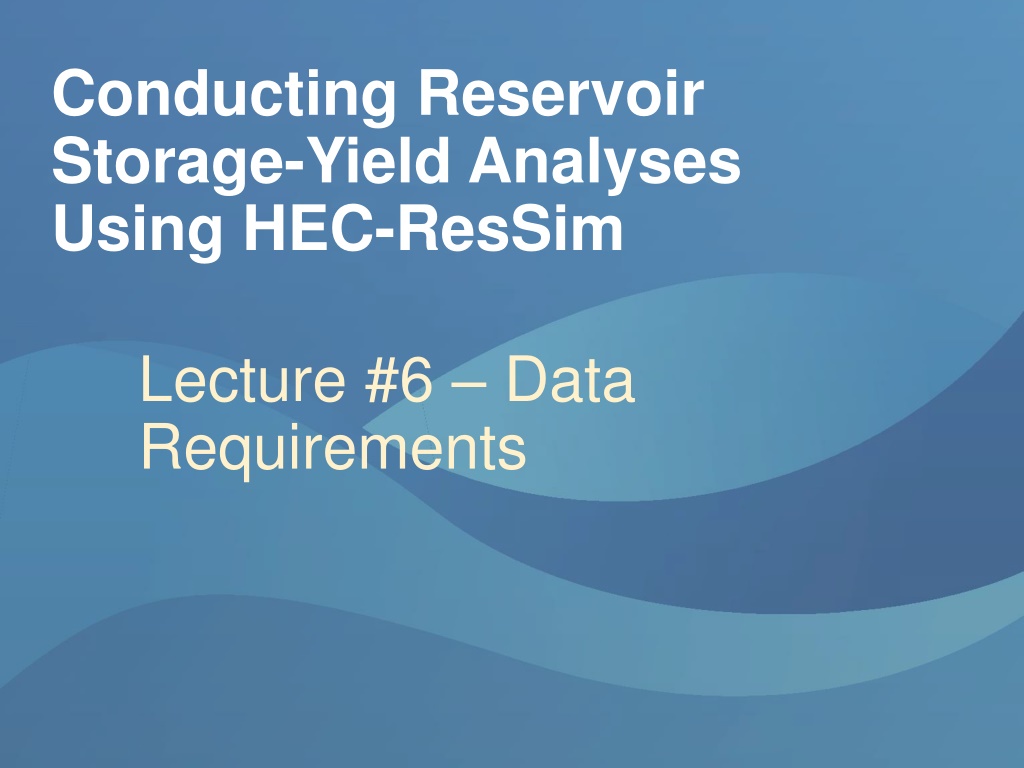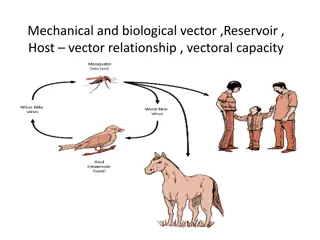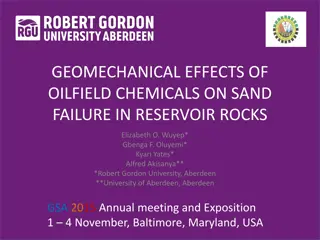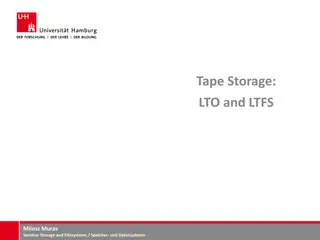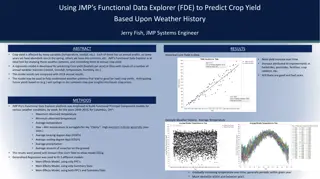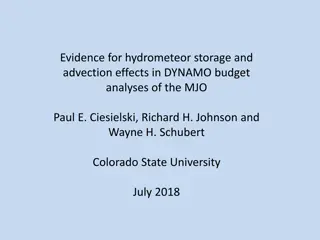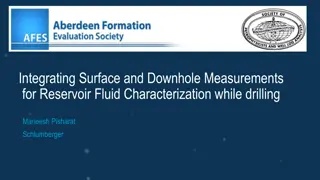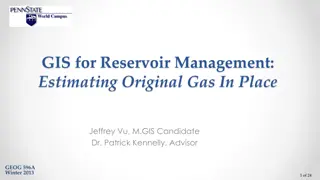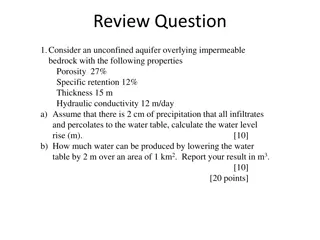Understanding Data Requirements and Inflow Calculations for Reservoir Storage-Yield Analyses
Explore the detailed data requirements essential for conducting storage-yield analyses with examples of data sources, emphasizing the significance of longer inflow records. Delve into the calculation methods for inflows using mass balance equations and learn about estimating inflows from nearby streamgages to enhance the period of record. Gain insights into the crucial aspects of model calibration, validation, and the impact of model details on firm yield outcomes.
Download Presentation

Please find below an Image/Link to download the presentation.
The content on the website is provided AS IS for your information and personal use only. It may not be sold, licensed, or shared on other websites without obtaining consent from the author. Download presentation by click this link. If you encounter any issues during the download, it is possible that the publisher has removed the file from their server.
E N D
Presentation Transcript
Conducting Reservoir Storage-Yield Analyses Using HEC-ResSim Lecture #6 Data Requirements
Introduction Discuss data requirements in further detail Show examples of data sources Describe inflow calculations
Data Data needed will depend on the study Existing reservoirs will have different data available than sites for potential future reservoirs Since firm yield is determined by inflow in the period of record, longer records are better
Data Required Optional Reservoir inflow or site streamflow Elevation-storage curve Evaporation and precipitation Validated reservoir model Local flows downstream of reservoirs Reservoir seepage or leakage Diversions from reservoir or river Historical operation data (elevation and outflow) Expected demand / demand pattern
Model Reservoir model needed for iterative simulation Model should be well-calibrated and validated Model should use expected future operations Model details can significantly affect firm yield result
Inflows The most important data for a firm yield study Inflows determine how much water is available in the system Typically calculated rather than measured
Inflows Inflow can be calculated using a mass balance equation with outflows and pool elevation ??????? = ?????? ??????? ? ?????? = ??????? ? + ??????? ???????=???????? ???????? 1 + ???????? ?
Inflows Inflow and Outflow can be broken out into components ???????=???????? ???????? 1 + ???????? ? ???????+ ????? ???????= ???????? ???????? 1 ? + ????????+ ????+ ?????+?????+?????
Inflows Inflow can also be estimated using nearby streamgages This technique can be used to extend the period of record or estimate an ungaged location
Inflows Methods available Drainage area ratio Regression Flow frequency curves Rainfall-runoff modeling ????????? ?? ???????? ???? ??? ?????? = ???????? ????? ?????
Outflows Outflows are used to calculate inflows Also used to compare model results to reality and verify model accuracy Typically measured by a gage or calculated from gate settings or power production data
Pool Elevation Measured by a gage Indicates the volume of water currently stored Used to calculate inflows Helps verify model calibration
Downstream Local Flow Flow into main channel between reservoir and control point Needed if there are flow limits at the control point or if the diversion is downstream of the reservoir Calculated using reservoir outflow and a streamgage at the control point ??????? = ?????? ????????????? Routing can be ignored if travel time is much less than the timestep
Surface Evaporation Very important component for firm yield studies Represents water lost to the system and unavailable for diversion Typically reported in inches or mm, volume of lost water depends on surface area Can be measured, but measurements may not be available
Surface Evaporation Evaporation data can be less available than other data Ideally, there will be a long-term record of pan evaporation at or near the reservoir with coefficients to convert from pan to lake evap If not, there may be pan stations close enough to be useful Temperature records can be used to estimate evaporation Example methods are Hamon and Penman-Montieth Be careful to calculate free-surface evaporation, not evapotranspiration Average evaporation can be found in NWS atlases 33 and 34
Surface Evaporation Evaporation can have a significant impact on firm yield Not accounting for evap can lead to optimistic yields Droughts typically will have evap rates higher than the long-term average
Surface Precipitation Precip on the reservoir surface is similar but opposite to evaporation Precip adds water to the reservoir directly Measurements are made by gages, radar, and satellites Sometimes less important than evap
Seepage and Leakage Some reservoirs have significant losses from seepage or leakage Lost water may flow into channel downstream of dam, or percolate into groundwater and be unavailable for use Loss may be constant or dependent on pool elevation
Data Sources Study data can be obtained from multiple sources USACE reservoir records USGS stream and lake gages Other gage sources (state, local, private) Private reservoir records (power or irrigation companies) NWS evaporation and meteorological stations NCDC (now NCEI) precipitation records
Data Quality It is important to quality control any data you use in your study Garbage In = Garbage Out Check for values that are too high/low, repeating values, missing values, etc
Data Quality Bad data can often be fixed Replace from other data sources Estimate using nearby gages Interpolate over short gaps Apply any corrections with care Don t blindly trust automatic processes Document your changes
Data Resolution The study timestep impacts needed data resolution Firm Yield studies depend more on overall volume than shape or timing This may allow a long timestep to be used Other factors like water quality or power requirements may need shorter timesteps
Data Resolution Timestep should be short enough to capture important processes and operations Focus on operations that could impact firm yield HEC-ResSim can model a range of timesteps, from 5 minutes up to 1 day Most HEC-ResSim firm yield studies will be daily
Inflow and Models Generally, any inflow component that will be modeled explicitly needs to be separated from the inflow time series This prevents double-counting and ensures accurate model results when simulated conditions differ from historical conditions
Inflow and Models Inflows calculated using mass balance are net inflows (after any losses or gains occur) ??? ???????=???????? ???????? 1 Evaporation is implicitly accounted for What if we need to model a different evap volume from what happened historically? Further processing is needed to make evap losses explicit + ???????? ?
Inflow and Models ??? ???????=???????? ???????? 1 + ???????? ? We need gross inflow, not net ????? ???????= ???????? ???????? 1 + ????????+ ????+ ?????+?????+????? ??????? ? ????? ???????= ??? ???????+ ????+ ?????+?????+????? ???????
Inflow and Evaporation Example: A given reservoir has these observed values on July 15 1980: Pool elevation: 750 ft Surface area: 3100 acres Net (calculated) inflow: 500 ac-ft Outflow: 0 ac-ft Evaporation: 0.2 inches Spreading the evaporation over the surface area gives a volume of 52 ac-ft lost Gross Inflow = ?? Inflow = 552 ac-ft Gross 0.2 in 52 ac-ft Net Inflow = 500 ac-ft ????? ???????= ??? ???????+ ????+ ?????+?????+????? ??????? 500 0 552 0 0 0 52
Inflow and Evaporation Example: 52 ac-ft evap loss historically Model state for same day [historical values]: Pool elevation: 720 ft [750] Surface area: 2000 acres [3100] Evap volume should be 33 ac ft Net inflow should be 552 33 = 519 ac-ft Gross Inflow = 552 ac-ft 0.2 in 52 ac-ft 33 ac-ft Net Inflow = 500 ac-ft = 519 ac-ft Net Inflow 0.2 12 2000 =
Inflow and Evaporation Using net inflow in model is wrong if modeling losses explicitly Volume lost to evap in model should not match historical volume - even when the historical and model evap depths are the same Modeling evap while using net inflow double-counts evap need to use gross inflow Need to model with gross inflow, and model evap Any other flow components that change based on elevation or surface area must be treated the same way seepage, precip, etc If a component is constant for all elevations, it can remain lumped in inflow, and ignored in the model Anything that is modeled should be separated from inflow
Knowledge Check What types of data are most important for a firm yield analysis, and why? Inflow is the most important input, it controls the water available for all uses. Pool elevation, outflow, downstream local flows, and evaporation are also often important for a good firm yield study. Outflow and pool elevation are used to calculate inflow and to compare model results to actual operations. Downstream local flows allow the model to simulate control point flows and diversions below a reservoir. Evaporation data is needed for good estimates of storage volume and yield during critical droughts.
Knowledge Check What is a good timestep for a firm yield model, and why? Monthly and daily timesteps work well for most yield studies. These studies are affected more by long-term volume of inflows and outflows than the specific short-term timing of the flows. Averaging data over a day or month will not change the long-term volume. Which losses need to be separated from calculated inflows? Any loss that will be modeled in the study and that are dependent on a simulation variable. Evaporation will almost always be separated for a firm yield study. Seepage and leakage need to be separated if they depend on pool elevation or outflow rate. They can be left lumped with inflow and not modeled if they have a constant rate.
Knowledge Check If inflows are estimated from upstream gages, does evaporation need to be separated? No. Evaporation is separated from mass-balance calculated inflows because the calculation gives net inflow after all losses are removed, and we need inflow before evap is subtracted, so we can subtract it ourselves. Inflows calculated by using upstream gages are gross inflow before in-reservoir losses are removed. Therefore we can (must!) subtract evaporation without any extra inflow processing. Can you safely use data from different sources in the same study? Yes, if you verify and quality control the data. Be alert for possible issues such as different vertical datums, inconsistent assumptions, and differing resolutions.
Workshop #3 Data Requirements Inflow calculation Accounting for evaporation Extending study period and comparing results to earlier workshops
